Regina Saphier: Unique Digital Art Experience in Painting
Posted: September 1, 2015 | Author: The Virtual Human | Filed under: English Text, My Digital Art | Tags: 1905, Apple iPad, art, art history, ArtRage, Berény Róbert, David Hockney, digital art, digital drawing, Digital Fauve, digital painting, Early 20th century, Fauve, Gergely Barki, Glenn Gould, Google Art Project, Google Cultural Institute, Google Earth, Google Maps, Google Street View, Ingmar Bergman, Magyar Vadak, Monaco, Róbert Berény, Samsung Galaxy Note 10.1 Tablet, Samsung Galaxy Note Pro 12.2 Tablet, Van Gogh, Wacom Cintiq 27QHD |Leave a comment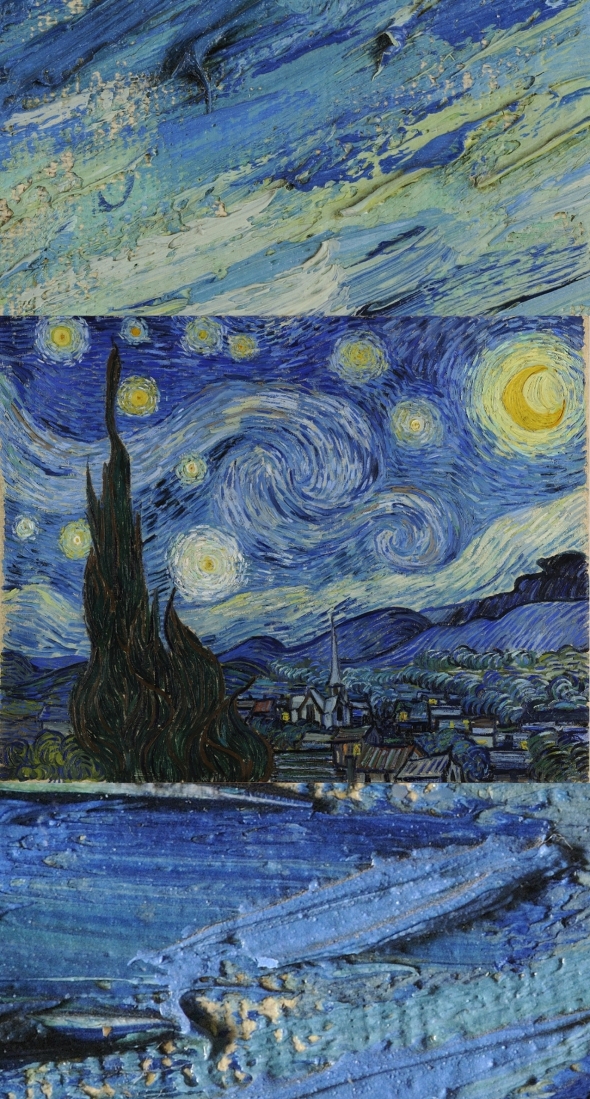
Van Gogh: The Starry Night… I added a few magnified and magnificent brush strokes to the picture… click the image and go to the link to zoom and have fun! (Image source: google.com/culturalinstitute/project/art-project)
Regina Saphier: Unique Digital Art Experience in Painting
Above: Vincent van Gogh: The Starry Night (1889) … I added his brush stroke details at the top and bottom of his painting. Notice the 3D appearance of the pigment. Some segments are even chipped… these details are beautiful and yet not observable by the naked eye… We need digital technology to show them online… I love to look at these details on the Google Cultural Institute’s Art Project page… click the image to be able to zoom into this beautiful painting and explore the texture. You can hardly expect any museum to let you touch a Van Gogh and look at it with a magnifying glass from up close.
This essay is about digital paintings, “classical” paintings, about the outdated, power and oppression based, elitist terminology of “uniqueness” and the elusive concept of “the original”… about what is “authentic” and what isn’t on the art market… about ever changing values, perceptions and the subjectivity of “market value”… about the best for a few, or the excellent for everyone… about the definitely original and the possibly original selling for the same amount on the global market… about Google Earth and Street View as artistic inspirations and amazingly as tools of an art historical discovery that I made during the process!
What matters is not the medium, not the surface… rather, it is the neural experience of the creator and the observer… The key is the merging and the synergy of experiences.
What is original? Artistic versus market value.
In my humble opinion, art “happens” between the brains of the creator and the observer, more specifically, between their brains, neural networks, synapses, neurons, the physical features of photons and the surface of the medium. The medium of representation or creation itself is marginal when it comes to artistic quality. According to David Hockney (one of the most important contemporary artists today), it is “the hand” that matters. I say, it is the personal neurology that matters. I think we are talking about the same thing, I am just a bit more scientific. And that personal neurology is what makes something original to the owner today (not the canvas and not the oil). However, the untrained (and sometimes even the highly trained) observer is easily fooled by skilled forgers and so it is really hard to say what it means to have the original. It appears that believing that something is original satisfies most people. So, it is the belief that matters.
Estimating the market value of art is a completely different problem. Or is it? It is not about how artistic something is, not about the fingerprints of the specific artist’s hands (it is not about the artist’s hair in the oil on the canvas), not about how original it is as the result or product of a creative process (from a qualitative point of view). The financial or market value depends on the joint narrative, the PR of the seller and the psychology of the buyer.
An original oil on canvas Van Gogh on the museum wall shows less of the artist’s “fingerprints” (or hair for that matter), than a HD digital photo that permits unbelievable zooming into the artist’s brush strokes. I am sure Van Gogh would love to try digital painting after seeing his own brush strokes digitally magnified. He would see how brilliantly expressive it is. Also, many of his paintings would still be visible instead of being under another painting because he had no money for a new canvas. I would rather have more Van Gogh paintings, even if digital! Again, it is not the medium, it is the neural and visceral experience that matters!
So, we have belief and narrative behind the artistic and the market value. Both are phenomenally subjective. Humans are able to form beliefs, values and narratives in relation to digital art and anything else in life. It is how we function. Both traditional and digital art depend on acquired preferences and value systems. In the age of Bitcoin you can easily attach market value to digital art. In the digital age you don’t necessarily have to own the “one and only” original.
Originality in music, literature and cinema
Think of music
If you want to think about the incomprehensibility of the term “original”, think of classical music, think of Bach and the Goldberg Variations (a variations based composition that Glenn Gould recorded twice, both before and after he stopped playing to a live audience… he stopped because of his fear of airplanes and hatred for his audience… the youngish version was recorded in 1955… next he stopped flying in 1962 and recorded the old version in 1981 in a state of the art studio, just a year before his death). You can obviously not have Bach in your living room to play for you. You would need Glenn Gould to come and play if he were alive, but he is as dead as Bach at this point. Plus, in the end even a Glenn Gould concert was hard to find… even when he was still alive.
With visual art, next to having Van Gogh sit in your garden painting your almond tree (impossible), the next best thing today is owning his original Almond Blossom painting (also impossible) he created for his brother’s bedroom when his child was born, a few months before Van Gogh died.
In music, what is original? Bach playing his own composition for you directly? Not possible. Glenn Gould playing his own youngish interpretation of Bach in a concert hall? Young Glenn Gould’s impetuous studio version? His meditative version he recorded as an old man? Or is the original the music scores noted by Bach’s hand on paper? And how do you define originality when you purchase the Goldberg Variations by any artist as a file? (I always preferred listening to classical music alone with my eyes closed, to sitting in a concert hall in bright light on an uncomfortable chair with strangers I never wished to see… except of course that unique Sviatoslav Richter concert in Graz, Austria two decades ago… he played in a darkened room at night and only a candle was burning on the piano… that was all the light during the concert… I loved the experience!)
While I developed this essay, when I reached the idea of music, I opted for Glenn Gould as an example instinctively. And suddenly I found that he actually also contemplated musical and any kind of artistic originality and authenticity, precisely because he basically became the technical director of his studio recordings after he discontinued his concert pianist career. Interesting to find that he also came to the conclusion that there is a “pathetic duplicity” when people go from hysterically celebrating a painting as original to hysterically hating it once it is scientifically shown to be a forgery. I agree with him. While I dislike deception, aren’t overpriced art, luxury product marketing and romantic love all based on (self) deception?
Think of literature and cinema
What is original and unique? Take Ingmar Bergman’s “Scenes From a Marriage”. Is his script “the original” that he wrote within a few months? His miniseries that he directed? The book that contains his story? The stage adaptations? Initially, all people had in the past was the story teller, and later the theater with people on the stage. Next, as more and more people could read, there was the book. In the modern days the movie theater was invented. With the book and the cinema the story teller and the actor did not have to be present in real time. Today you don’t have to be present in the movie theater, you don’t even need to watch television, you can listen to an audio book, read on your kindle and watch films from files at home. What is original and unique? In every case it is your personal experience that is unique, as you lose yourself in the artist’s projected experience. The medium does not dominate your experience, even if reading a book, listening to a reader, or watching a film are different types of experiences. Independent of the medium there will always be your very personal experience.
Is something original if you have to pay for it (a little or a lot), or is it still original when you get it for free in an era of unconditional basic income in the future? Keep thinking: What is really original in an endless universe? Just how original is Earth itself in a Galaxy of hundreds of billions of stars, in the Visible Universe of at least a hundred billion other galaxies?
Power and leadership in the digital age
Originality and authenticity are outdated social constructs of a snobbish and power hungry elite who are also digital immigrants and often technophobes. The digital natives only nowadays begin to have a voice.
Here are the words that represent and describe the old and fading concepts of originality and uniqueness in my opinion (in art market terms of paintings these are not about talent, nor about personal creativity): money or funds (financial value, financial agreement based on an object that was created only once by someone well known and celebrated), status quo, elitism, common belief, (artificially created) scarcity, narrative (real or manipulated), PR (always manipulated), subjectivity, impressionability (lack of knowledge), self deception, perception, attitudes, the illusion of objectivity, illusion in general, changeable social and personal values, social and individual psychology (the need to fit in and/or build an identity), acquired preferences (based on own networks), oppression, exploitation, despotism, wealth, egotism, selfishness, questionable power and influence, competition and success of the few at the expense of the many, emotions and ever changing culture(s). This is where we are coming from.
As the digital natives with new, enlightened and timely values become leaders, these words and concepts will hopefully begin to fade during the next couple of decades.
The equal market value of the “definitely” original and the “probably” original
Let me give you a completely contemporary and fresh example how passing time, changing values, skillful PR, impressionability, acquired preferences, egotism and scarcity create inflated market “value” and also increase artistic “value” perception. It could be any artist, so the names in the story are not important. My goal isn’t gossiping, my goal is to be able to give you a raw example.
The artist was born in Hungary, yet she is regarded as one of the most important Indian painters (her mother was Jewish Hungarian, while her father was Punjabi Sikh). She died young in India (she was only 28) and most of her paintings are either in museums or in family collections. Most of her paintings are in India. Few of her paintings are in Europe, but these are in much better condition, due to the climate. For decades her art did not have much global market value (her highest prices a few times were around a few hundred thousand dollars), until an ambitious, talented and middle aged Hungarian gallery owner decided to acquire her well documented self portrait from a Hungarian family member (the old man, who as a little boy knew the artist, took care of the painting for decades, and this ensures authenticity… this historic detail adds value). The gallery owner took the painting to Sotheby’s and set down with a dedicated professional team. The networking started and a well crafted PR story unfolded targeting rich Indian men…
The created narrative was that here is this phenomenally talented and sexy, pretty young thing with her red lips and beautiful gaze who died in her prime after having studied in Paris, and just before she could reach her artistic peak in India. The narrative worked, the painting was sold for nearly 3 million USD in New York in 2015, surprising even the extremely ambitious seller and the highly experienced team (and also angering the son of the old family member who sold it to the Hungarian gallery owner). And the power game begins, behind the scenes for now… to the point of the gallery owner supposedly trying to suppress articles on the internet regarding the record sale! (Just how much of an ignorant and egotistic despot are you… man…?) And to the point of the original owner’s family supposedly taking legal action against the gallery owner. How lovely! It is morally puzzling to me why the gallery owner did not offer a joint sale of the painting in the first place. It is also unclear to me why the original owner did not go to Sotheby’s directly… (I mean, he is fluent in English.) Just why do I have this uneasy feeling that this story is based on exploitation, even if in local terms the original owner probably received a nice amount of money…?
This is what happens when the market value of something is artificially and suddenly inflated. This has nothing to do with artistic value. This story of “value creation” unfolded without the knowledge of the supposed global “authority” of this particular lady artist’s work in India, a family member, who has never met her in person. He was stunned when he got the news. An old, mediocre artist, who is basically recycling his aunt’s art… So, when suddenly the aunt’s self portrait was sold for millions of dollars in the US without his knowledge and without his “royal” assent, he found himself insignificant (despite his many inherited paintings by his aunt suddenly having a record market value… his inherited collection in India was suddenly at least six times more valuable, because of this one sale in New York that he did not even know about).
Next thing you know, another self-portrait by her, out of nowhere in France pops up and now the old Indian relative is asked for approval before the Christie’s auction in London (probably via e-mail). To the best of my knowledge (and rest assured, I have not read this complex story anywhere, rather I harvested information from my network) he simply looked at a photo of the newly discovered and completely undocumented self-portrait (it wasn’t published anywhere and nobody knew it existed) and gave his immediate validation that it is definitely original. Just like that. Long distance. Almost like a clairvoyant. WOW! This, and only this nuance made the major sale possible in this case! He has not known about the painting beforehand, he did not hold it in his hands, he also isn’t an art historian, neither does he occupy himself with the chemical laboratory analysis of the pigments or the review of X-Ray imaging results of the deeper layers of the painting. In the golden age of technology, he simply looks at a photo and “knows”. Yeah, “right”…! And the painting that was not even documented in this so called connoisseur’s detailed and heavily illustrated book about his aunt (full of her letters and paintings, and her narcissistic father’s photos), was sold for over 2.5 million USD in London in 2015.
Without the sudden and rather superficially issued consent by the Indian relative, because this painting was latent until recently (unlike the other, well documented and well known painting sold by Sotheby’s in New York), nobody could have sold it in a major auction in London at Christie’s. Her market value was absolutely expected to go up, but not as suddenly and not as high as this. But now her art is at the top of the female Indian painters’ market value short list (within a few months), based on two early self portraits sold in the US and in the UK. The definitely original and the probably original sold for almost the same amount, there were only two hundred thousand dollars between the two final bids. Imagine when the old owners of her paintings begin to pass away in Europe or when some of her more mature work hits the market in India (her paintings can not be taken out of India, so once you take her art from Europe or from the US to India, that is it, it stays there).
Here is the extra grotesque part!
There is a heavily researched painting in Hungary that was acknowledged to be her painting by many experts and even a family member. The painting was exhibited in one of the major museums in Hungary. All sorts of tests were done, including X-Rays, different types of photographs (ultra violet light, infra red light, high definition, etc.), pigment analysis and so on. Yet, it cannot be sold at any auction in New York or London, because get this: based on photos alone (!) the Indian family member decided years ago that it is not his aunt’s work. Again, just by looking at photos. He never examined the painting itself and never explored the research material. But even if he were to examine it in person, he admits that he is not an expert. He does not issue an expert’s statement, no matter what. Yet, a multi million dollar sale depends on his superficial and subjective opinion. Is this what should determine what is original or unique today? Definitely not! Yet it is what is happening.
Technophilia and Technophobia
“Technophilia (from Greek τέχνη – technē, “art, skill, craft” and φίλος – philos, “beloved, dear, friend”) refers generally to a strong enthusiasm for technology, especially new technologies such as personal computers, the Internet, mobile phones and home cinema.” (wikipedia)
“Technophobia (from Greek τέχνη technē, “art, skill, craft” and φόβος phobos, “fear”) is the fear or dislike of advanced technology or complex devices, especially computers.” (wikipedia)
Technology is constantly evolving while the human intellectual and aesthetic evolution appears to be slower. Most people lack the intellectual independence to make up their minds about something new (and also about most of the old as well). People seek out opinion leaders (not necessarily true and reliable experts) to know what is original, what is valuable, what is authentic. That is rather sad but true. Most people aren’t independent thinkers, yet many assume an individualistic pose.
Anything can be artistic or original (if you like). If you have an oil on canvas Hockney, a montage Hockney, or a digital painting of Hockney, all of them were created by his hand, his brain, his neurology. And in each and every case the medium is also part of the end result (but only one part… it is not the key aspect of the artistic value and should not be a key aspect of the market value either in the twenty first digital century). Emotionally the impact will be the same if you have the right values and a high quality product. It is the values, the psychology, the narrative and the quality that matter, not the medium. You will see and feel what he wanted you to see and feel… a UK landscape in LA’s bright light for example… no matter what the medium is, if the product comes with a high quality.
Today, a digital painting’s market value, for example a monumental digital Hockney’s (even if it is made of smaller parts), might be determined by the fact that he has decades of contemporary success behind him, that he was invited by the Royal Academy of Art in 2012 to display his digital paintings and that each monumental digital painting was printed only once, so only one exists or only a limited number of them exist (depending on the agreement). It does not matter if it was painted on canvas, paper or on an Apple iPad or on a Samsung Galaxy Tablet Note 10.1 or a Note Pro 12.2, or perhaps on a jaw dropping Wacom Cintiq 27QHD Creative Pen and Touch Display for 2800 USD… plus 400 USD for the Ergo stand and 100 USD for a more capable Wacom pen… all together my dream tool is approximately: 3300 USD… I think that is without software… (note: software for android devices is much cheaper than for windows or apple products).
A demo of how the Wacom Cintiq 27QHD is used in animation:
Digital artists, who come after Hockney, don’t have to walk the same path, because he represents the transition from traditional contemporary art to the digital contemporary realm. The fact is, anyone could reach some level of artistic value. However, if you have some sort of classical visual culture (you don’t have to be academically educated, it is sufficient if you were surrounded by classical art or if you trained yourself visually), a person might be able to create much stronger and intellectually much more stimulating digital paintings, compared to those who were only exposed to the “aesthetics” of online games (note: there are very few aesthetically excellent online games). On top of this, the artistic and market value also depends on the cultured and/or sensitive audience or observer, again, a highly subjective component in the values game. Some are receptive, some aren’t. Some people are in touch with their latent inner artist, existing somewhere deep down, and some are completely out of touch with their creative emotional selves.
It is puzzling that most contemporary artists are technophobes…
Uniqueness in the digital age
In the digital age, when humanity attempts to make the most possible quality items available to the most possible people (like the cheap, yet excellent ArtRage software for android is a celebration of the long tail economy, while the Samsung Galaxy Note 10.1 or Note Pro 12.2 Tablets are also excellent), “uniqueness” becomes a highly questionable term.
Uniqueness in economic and market terms (not in artistic terms) speaks about the assumed needs of the elite, about privilege, power, money, wealth, or in other words about inequality, the oppression, exploitation, enslavement, dependency and suffering of the masses. (However, today people are learning at a rate like never before, so change might be on the horizon.) The rich buys “the one and only” at the expense of the poor. Something that is unique is a beautiful thing from one point of view and a very dirty one from another. Holding onto the shockingly expensive and to the traditionally unique represents an attachment to the despotism of an outdated and unenlightened era. A rich person is not better, nor more deserving than a poor person. An artist using oil and canvas is not a better artist than one using digital tools to paint and provoke some sort of emotional impact.
Hockney did not come from a privileged background. For a long time, among many things, he used oil. Today in his seventies as a famous and well to do artist he is also creating digital art. He is still undoubtedly creating Hockney paintings. The old medium does not dominate the artistic value, so it should not dominate the market value either. Of course the most sophisticated forgers are able to show people that even the artist is obsolete, when someone makes a skilled copy and nobody notices (only an Artificial Intelligence tool will be able to distinguish the original from the fake after a while). I know that “cultured” people are attracted to owning the original, but I don’t think that this is an inborn and necessary feature of humans. This is something we learn. So, this is also something that we can unlearn or reform.
Apparently it is the experience that matters. The artistic experience is formed in the observer, in his or her neural network, based on the available information (based on learning and feeling). How immense this artistic experience is depends strongly on the narrative. Art is a mental and social experience, embedded into an ever evolving narrative.
David Hockney talking about his digital art
About my digital art
I suddenly and only very recently started to learn the art of digital painting. By the end of July of 2015 my most amazing dog-sister passed away and my hunger for emotional expression resulted in sudden bursts of artistic activities. I finally gave in and accepted my best friend’s suggestion that digital painting was invented for me. He kindly lent me his Samsung Galaxy Note 10.1 Tablet and introduced me to ArtRage, a phenomenal digital painting software. Practicing graphic art is a new phenomenon in my life. Finding flow beyond blog writing to forget about loss… Turning pain into digital paintings to definitely see the beauty of life.
Two weeks after my brilliant dog’s sudden death I posted my first “presentable” digital painting (my third digital painting ever) on my facebook wall to a select few friends. It was a freehand digital drawing and painting based on my spring time smart phone photo of a nearby salmon pink Bauhaus building (note: there will be a composite image of my learning process later in this blog text).
Apparently it is a general practice today to paint from digital photos. In fact I just read a few days ago that hundred years ago Pierre Bonnard took photos of his family home and went to his art studio to work where several canvases were stretched on the walls (not on regular stretchers). This is how he created his uniquely intimate paintings. He also did not determine the size of his painting until it was completed (note: in the windows version of ArtRage one is able to enlarge the canvas if necessary).
You can look up and observe the old, but renovated Bauhaus building that I painted (find it on Google Street View if you like). It is 3 Napraforgó Street in Budapest’s second district (Napraforgó means Sunflower), very close to my home (I like to walk there, the entire street is part of a special housing project from better times in this country… it feels a bit like it wasn’t even in Hungary, rather somewhere in the UK… you almost expect a character like Belgian detective Hercule Poirot to appear). On my digital painting I intentionally made it look like the building was located somewhere on France’s Mediterranean coastline, because I used to own a Róbert Berény painting that he created at age 18 in Monaco at the very beginning of the twentieth century. I loved it. I always fantasized about one day painting rooftops for example. In fact “my art rage” started five days after the emotional trauma with my attempt to draw a “tree still life” on a tablet (to see how it works) and next (two additional days later, on July 27 of 2015) I attempted to recreate the atmosphere of my long sold work of art by Berény (an oil on cardboard) that used to hang in my bedroom in my former apartment. (Note: see the composite image of my learning process below.)
Frankly, after I had a professional photo reproduction on my wall for years, I don’t feel any real difference. Initially, it was painful having to sell the original, but I was happy to hang a high quality photo reproduction on my wall in the original frame. It is the emotional composition, the sight, the style, and the colorfulness that I like. I simply don’t care anymore that it is not “the original”. It is still unusual that I own a large and high quality photo reproduction like this one right here on the wall (I am sure, I am the only one with this experience). It is even more meaningful to me that I created a remake of the 1905 painting, because I discovered new details on the painting itself (there is not only a black winter coat, but there is also part of a blue winter coat visible in that same window). And not only that! I even discovered on my own where the painting was created in Monaco and I created my own rendering of the same courtyard as seen from another point of view! This is new information that could enrich our knowledge of Berény and his art. I will tell you the story (in words and in pictures) later in this blog post… Wait for it and read on to better understand what I am doing!
My evolving artistic self
I think I am approaching my personal style that I feel like calling “Neuro Fauvisme Digital” or “Neuro Digital Fauve Expressionism” or “Digital Neuro Surrealism“. As in my inner city photos, the same way on my digital paintings there are no people (also no animals except a hidden and small female black dog in each and every painting, representing the highest levels of loyalty, independence, curiosity, tolerance, love, devotion, truth and intelligence). I work with high tech to create images that resemble the art that was created over 100 years ago in Europe, because that is what I like. I am looking at Google Street View, walking through cities of Europe, finding landscapes and architectures that speak to me and I depict them manually, yet digitally, as if I walked through old towns and villages during summer siestas in 1904 or 1907. These images are my inner walks. My introspective nature is reflected in them.
Despite the high tech that I am using, there is nothing modern (no modern technology) on my digital paintings. I depict cities, homes and structures that contain human communities, that were created by people. No cars, no motorcycles, no digital displays, no traffic lights, no airplanes, nothing like that. Today, I am painting a pre-digital world, with a digital medium (but this might change as my art evolves… I am going to paint as long as I enjoy it). Until now I didn’t create visual art, because I was uniquely surrounded by hundreds of paintings created by (in large part female) artists who were active before W.W.II. Painting traditionally did not appear to be a particularly unusual or special activity to me. However, painting digitally in a pre-digital style felt fascinating to me. My evolving art is a colorful reminder of the Belle Époque before WW I., just when modern technology started to overwhelm us. I love modern technology (I am a female technophile), but I find my flow in taking a paradoxical break from it and wandering (off) visually, mentally and emotionally in(to) a long lost world. Any decent introvert will understand what I mean.
Look, I know that one can’t paint for 30 years within 3 weeks. I know I am a total beginner. People still like to compare my pictures, atmospheres and motives to paintings by Chirico, Escher, Matisse, Hockney, Berény or Csontváry and the like (interestingly and tellingly: not one female is listed, ever). The thing is, I don’t paint like any of them. I paint like me. No need to copy anyone, beyond obvious learning reasons. Yet, I was definitely shaped by the art that I observed throughout my life. I am just learning to paint (on my own), and see what happens. Stimulating (in)sights… loving life… optimism… yet a melancholic observer, a dreamy outsider… My images carry my contradictions. The traveler who is in one place all the time lately.
I write and paint as if I lived in California or New York in the US. Yet I live, write and paint in Budapest, Hungary, Europe. My subjects are located thousands of kilometers away in eg.: the Mediterranean region of Europe. I absorb, read, write, paint, express and display digitally. When you look at my paintings, imagine them as large printed colorful canvases in a foyer or lobby of a lively, elegant home, hotel, museum or restaurant in San Francisco, or on the wall of a magnificent loft in New York. This is what I have in my mind when I am between two paintings. But much more importantly, when I paint I have nothing “on my mind”. It is exactly why I paint. I like to be lost in space and time. Writing is more of a left brained flow experience, painting is more of a right brained flow state. This is how I find my path, my truth… via a whole brain experience. This is my way of celebrating life. I never party, I don’t use substances, I am not dependent on a defined group of people and their opinions. I do my own things. I am my own person. Yet I am highly connected to the world online.
What is unusual is that I have been doing this sudden artistic activity for a few weeks only… yet, it feels like it has all been waiting there inside of me to suddenly happen. I don’t even have to think about my concept when you ask me. It’s there, even ready to be written, as you can see.
My learning process
It pleases me enormously that I finally have an outlet for my serene self. My blogs are full of pensiveness. Painting balances me and helps me show my true inner range. And in surrealism anything is possible… you can have sunlit nights, with dark sky and bright, colorful walls.
Before I start drawing the sketch, I spend some time looking for my next subject for a few days. I pick sights that give me a particularly good feeling. I select subjects that I suddenly start seeing as a painting.
Three weeks into the self guided learning process this is what I produced:
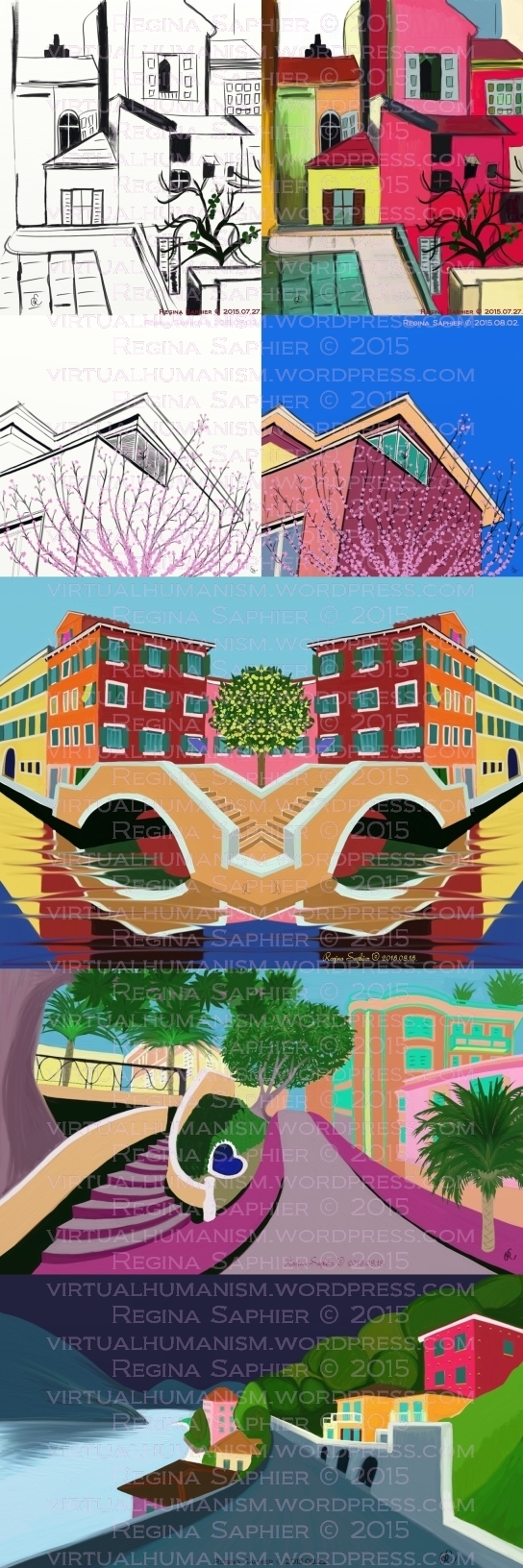
a., Remake of Róbert Berény’s Monaco Painting by Regina Saphier 2015 (Freehand Digital Drawing & Freehand Digital Painting)
b., 3 Sunflower Street with Cherry Blossoms by Regina Saphier 2015 (Freehand Digital Drawing & Freehand Digital Painting)
c., Venice with Lemon Tree by Regina Saphier 2015 (Freehand Digital Painting)
d., Monaco Rue des Iris by Regina Saphier 2015 (Freehand Digital Painting)
e., Lake Como by Regina Saphier 2015 (Freehand Digital Painting)
The first painting I posted on August 2nd of 2015 (the salmon pink Bauhaus building with the cherry tree) took me two days to create (I was still learning the software… had to get used to the digital logic of drawing and painting). The last one that I posted on August 22nd of Lake Como also took me two days. You can see the difference in complexity, yet both took me the same amount of time to create. It is unbelievably cool to experience what one can do within three weeks just by simply wanting to create images, by being dedicated and open minded. It still takes two days to complete a picture, because I am still learning while doing and I want to do well. Each time I wish to create something presentable in the end.
I skipped “the cube drawing phase” of learning (that usually takes months in a regular and formal drawing class… I don’t like boring training sessions… I did the same self-willed skipping while learning English… and yet I am able to write blogs in English about basically anything as you can see), and I do the practicing during the visual creation. I keep drawing the lines, until the “buildings” end up in the right position. I keep searching for the form, the shape, the depth, the perspective. I keep going back and doing it again, until I feel happy with the position and the composition. In a way I almost draw multiple pictures in some areas of the surface, until I end up with the final product that I like to look at, that shows the coherence I was looking for. This is why I call it eg.: “Digital Neuro Surrealism” (note: we all have a typical, personal handwriting, and I believe we all have a typical drawing and painting style that naturally happens while practicing). I don’t walk the academic path, it is dead boring to me.
I walk the neurological, instinctive path. Sometimes my frustration is enormous. I sit there and say: “Why can’t I draw?” or “I can’t draw!”… Because I see that it is wrong… so, I remove the specific area and do it again and again, because I know that I should be able to do it. I know it is possible, I just have to keep doing it. And suddenly I like it and I am happy and proud that I suffered through the frustration and that I persisted. When the sketch is done, I start painting the buildings on another layer (on my “Monaco – Rue des Iris” painting I put everything on the same layer and that is not the best approach with the digital medium… it is a good idea to use the separate layers, but technically it is more complicated… especially in the android version of ArtRage, because there the layers are not constantly visible while working)… and so on. Typically, I am not satisfied until I am done with the painting. There is a point where I feel that it is “ready” and I am happy with it (and I feel that I no longer wish to perfect it). I particularly like red buildings (red will be hard to print well, but I still like it).
During my discovery of the digital art realm I came across David Hockney’s digital paintings and listened to him as he spoke of his initial skepticism… Soon he realized, that this is a very serious and quick tool. I agree! Of course he is lucky that he has helpers dealing with the printing and mounting process. Perhaps one day I am going to print my paintings on canvas and hang them on the walls of my apartment along with other art.
Google Earth and Google Street View as brilliant sources of visual inspiration
Sometimes I point randomly onto an area of Google Maps or on Google Earth and zoom in on the Satellite Image of a particular city or village near a large body of water. I “take a walk” in places that I already have been to in the past, like the Côte d’Azur (I took many photos of the landscapes). When I discover the right place to depict, I walk around in Google Street View to compose my next digital drawing and painting. Luckily, due to my many travels, I have a realistic feeling of many places on Earth. I know how it feels to be there.
What is unique about this process, is that Google Street View is created from an angle that would be humanly and practically impossible to work from. Google Street View cars have a long pole on top carrying complex cameras that take multiple images at once as the car moves along the way. This is how the stream of image bubbles are created around the world. If I wanted to assume that position, I would have to sit on top of a ladder on top of a car and would have to maneuver the car back and forth while also painting, and that in the middle of the road. In my opinion Google Street View is a creative and open minded artist’s best friend. I don’t know if anyone is using it like I do, but it was a natural choice for me.
My digital or virtual self and a possible future
For many years I worked on an all digital writer self… I absorb knowledge digitally and I spread knowledge digitally via my blogs. Now I have another opportunity to be 100% contemporary and digital. I look at Google Street View with my human brain and eyes and I create a digital painting manually, filtering the sight through my personal neural network and neurons. Often, in the middle of the painting there is the road, representing life as a continuum and I take you into a (modern) technology free world that actually does not exist anymore. At this point, my freehand digital paintings look like illustrations in children’s books and I really love that. This is all so unexpected and gives me so much joy (after the sadness of loss of a loved one and beyond the understandable frustration of learning).
For an added texture I might one day attempt to 3D print my freehand digital paintings instead of simply printing them on canvas. If you look closer, ArtRage is able to detect your manual movements, hand pressure, etc., and is offering many tools and settings that give you the ability to create real texture. (One is able to add much more texture, I just opted for lighter touches.)
Painting digitally is more spontaneous, flexible, there is a lot of freedom, it is much more intuitive with all the tools compared to traditional painting. However, when I work with the digital stylus, I never copy or paste, I don’t put photos into the file, I don’t use digital shapes, I make everything possible manually (freehand).
I think what we need to do, is no longer a comparison of traditional painting and digital painting. We are already at the point where we should rather ask questions like: What would you see as original, a manually yet digitally painted painting by a human (printed professionally on real canvas), or an oil on canvas directly but created completely by an artificial intelligence driven robot without zero human intervention?
And at this point I think I just invented the AI navigated robot, that (instead of printing or even instead of 3D printing) looks at your finished digital painting file (not a computer generated image) and carries your exact movements (by learning the patterns of your personality, emotions and neural activity), painting your image move by move, on a canvas that you can hang on your wall, adding amazing extra texture to your digital painting.
So, as you can see, now as I am beginning to teach myself to draw and paint digitally, I did my share of thinking about this art form and field. I hope some or most of this essay was interesting to you.
Rest assured that this art technology will evolve and in a few years people will begin to acknowledge freehand digital (drawing and) painting as the serious art form it already is.
Remember, that in life and in art: It is the experience that really matters!
.
A small detail of my Lake Como painting:
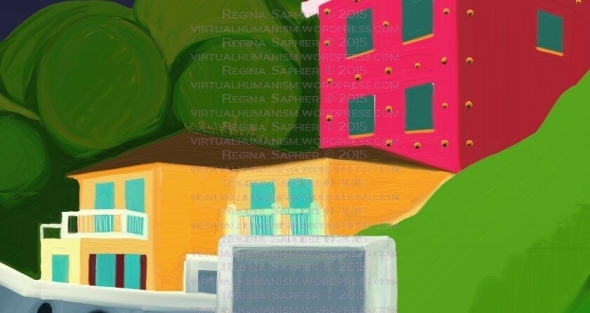
Lake Como by Regina Saphier 2015 (Freehand Digital Painting detail)
By the time I completed this blog (on August 31. of 2015), I also completed a new painting. Here are three versions of my “Le Pin Parasol”:

Three versions of my Le Pin Parasol. (Le Pin Parasol Capri by Regina Saphier Freehand Digital Neuro Fauve Painting 2015)
.
This is a detail showing the manual/digital brushstrokes on my Le Pin Parasol representing the sea and the trees (note: I opted for homogeneous waves, but you can go really wild if you change the settings of the tools):
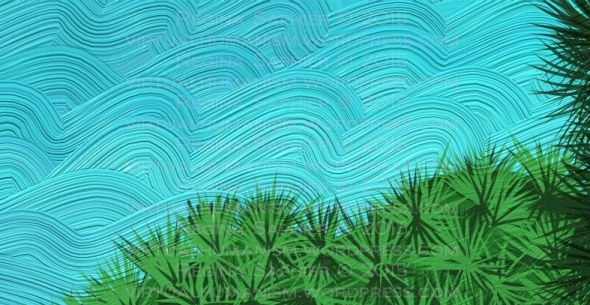
Le Pin Parasol by Regina Saphier 2015 (detail: digital brushstrokes)
I painted this sight based on a photo on Pinterest. There wasn’t much info… I only knew that it was somewhere on Capri, in Italy. I could see that the tree was a Stone Pine. I had a good feel for the entire spacial experience. As usual, I got curious and used my almost savant like skill to find the original location (note: I used to be the nightmare of real estate agents… I could find their advertised homes based on the smallest spacial information… just seeing a small part of a city, like a rooftop is enough for me… on several occasions I would wave at the agent from the specific building’s door while he or she would wait for me at some neutral corner… finding things on Google Earth is something I also like to challenge my friends with… it is so much fun!). I used Google Maps and Google Earth and within 5 minutes I discovered the exact place. I zoomed in and out and explored the area. If you are like me, you can find it based on my painting in 5 minutes too. (Here is the solution if you can not find it, but first try if you have the time… if you don’t, just highlight the section: Via Krupp)
.
But here is the really amazing discovery I made during this process!
I used the same savant skill and tools (that I described above) to find the place in Monaco where Róbert Berény painted his Monaco houses and rooftops in 1905. I created the digital painting remake to learn (note: the Samsung Galaxy Tablet that I am using and the ArtRage version on it are Android based), plus discovered the place on Google Earth where he created his painting. The address in my opinion is 23 Boulevard Albert 1er, Monaco. I think Berény was standing on the terrace in the courtyard (he was facing south on a sunny winter morning very close to the sea in Monaco) and he painted the north facing walls and rooftops of a few villas on Rue Princesse Antoinette (unless he took photos as many of his contemporaries did). If you look closely, even the characteristic glass bricks are visible from space. (See images below for a better understanding.) From Rue Grimaldi one is able to see parts of the buildings on Google Street View. The building that is yellow today used to be peach colored a few years ago … and before that it could have been pink or red. A lot has changed in over 100 years in Monaco… and yet the atmosphere is the same in this courtyard.
Young Berény (only 19 at the time) was standing behind the inner white structure (on the left side, as seen from Rue Grimaldi below) on a huge terrace and faced the smaller buildings (like the yellow one on the right side)… The colors were different in the past, plus his imagination also played a role. Of course some of the buildings were slightly reconstructed since the original Berény painting was completed in 1905, but the place is 100% recognizable. (I posted images of the original painting at the end of my post.)
I am assuming this is a historically significant discovery, this is why I felt that I should publish it immediately as part of my digital art related blog post. I used to own the painting, I created its remake digital painting as part of my recently started learning process and I spotted the special place while exploring the area for further artistic inspiration via Google Maps, Earth and Street View. I painted a street approximately 500 meters from this location in August 2015. I was getting closer and closer and suddenly I had the exact place. I felt obligated to share my discovery with everyone who is able to appreciate it.
Thank you Google! I love technology! I love art! I love to write! I love to paint! I love to do research! I love to discover! I love the experiences!
Here are a few images to help you understand my research result:

Young Róbert Berény’s inspirational courtyard as seen from Rue Grimaldi in Monaco… a lot has changed in over 100 years in Monaco… and yet the atmosphere is the same in this courtyard. Berény was standing behind the white building on a huge terrace and faced the smaller buildings like the yellow one… The colors were different in the past, plus his imagination also played a role. Of course some of the buildings were slightly reconstructed since the original Berény painting was completed in 1905. (Image source: Google Street View)
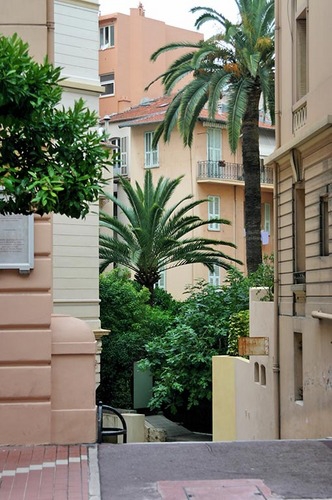
Monaco – Berény’s special courtyard as seen from Rue Grimaldi … the yellow building used to be peach colored … and before that it could have been pink or red … (Image source: Google search)
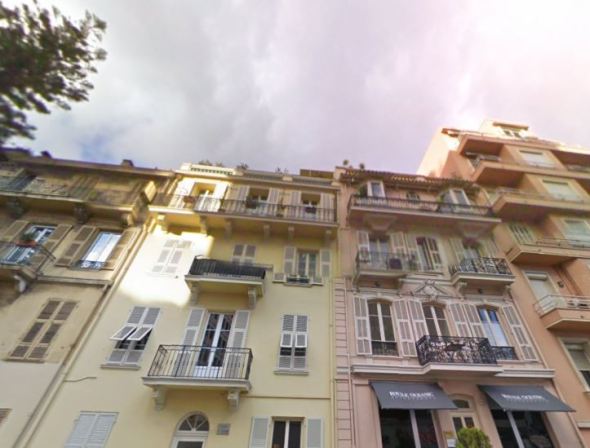
The villas on Rue Princesse Antoinette in Monaco… Berény painted their courtyard facing facades in my humble opinion (research by Regina Saphier virtualhumanism.wordpress.com) (Image source: Google Street View)
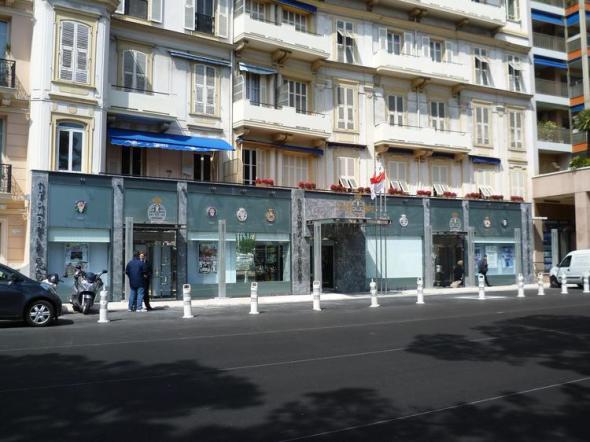
Automobile Club Monaco, 23 Boulevard Albert 1er, Monaco (research by Regina Saphier virtualhumanism.wordpress.com) (Image source: Google search)
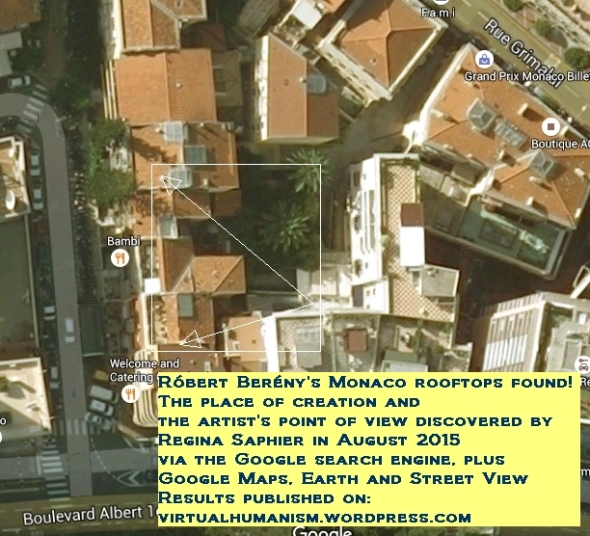
The courtyard today that inspired Róbert Berény in Monaco in 1905 … even the glass bricks are visible from space! (Place of creation and point of view of the artist researched and discovered by Regina Saphier in August 2015) (Image source: Google Earth)
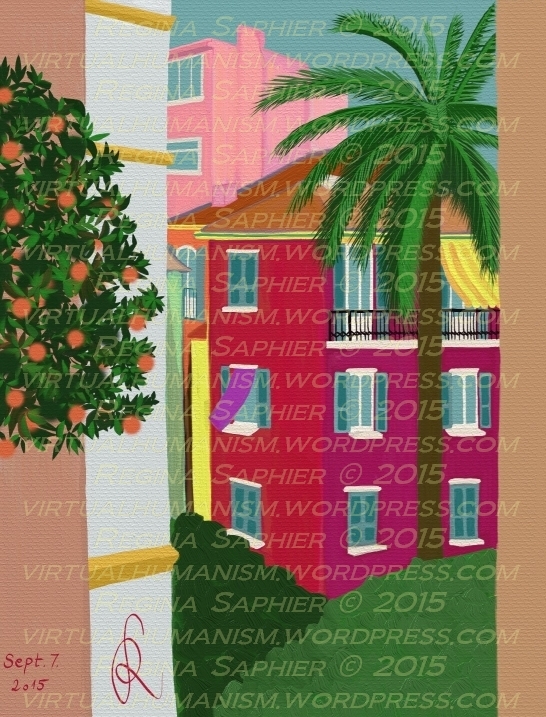
Visual Update: “The Secret Garden in Monaco” by Regina Saphier – September 7., 2015, day version, freehand painting on digital medium. (I created this painting from Rue Grimaldi after I discovered the courtyard where Berény painted his Monaco Rooftops. My world view, Berény’s motives and the location today are represented together in this visual synergy that reminds the viewer of children’s stories. I have to admit that I am surprised that I am capable of something like this just six weeks after I started my visually artistic self directed learning adventure, especially because I am only painting during the weekends.)
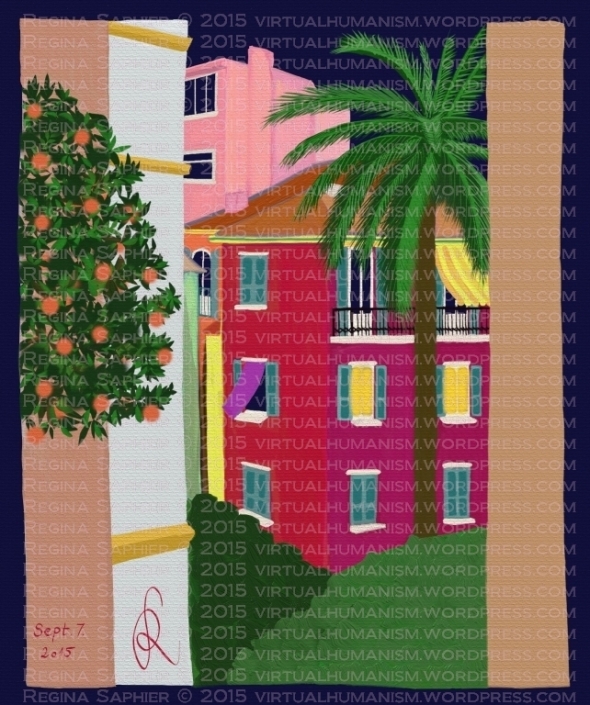
Visual Update: “The Secret Garden in Monaco” by Regina Saphier – September 7., 2015, night version, freehand painting on digital medium. I prefer the night version, because it is more dream like and mysterious. (Note: The dates on my paintings are the dates of publication.)
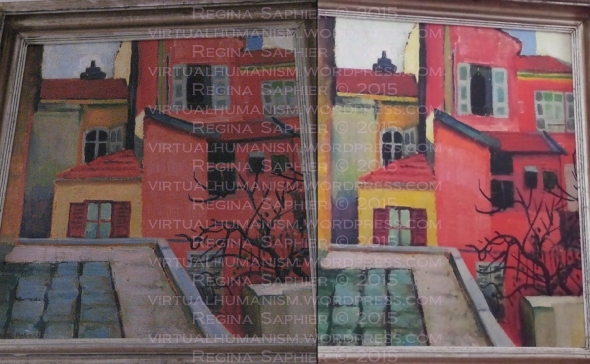
The original Berény painting on my wall and the photo on canvas reproduction Berény on my wall
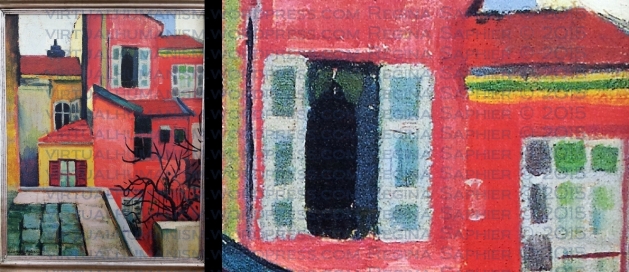
Berény’s Monaco and the window detail with the black and the blue winter coat (I discovered the blue coat after I created the remake, painted the new rendering of the courtyard and the buildings and wrote this blog post… suddenly I noticed it on my own photo) – smart phone photo by Saphier Regina 2015
UPDATE!
In case my fascinating story that I discovered the place of creation in Monaco of a Hungarian Fauve painting (by Róbert Berény) that I used to own wasn’t exciting enough (as part of this blog post in English and as the main topic of my latest Hungarian blog post), let me add this:
Gergely Barki, the number one Berény expert in Hungary was in Monaco at the very same time looking for the location where Berény created another early painting depicting houses in the Port of Monaco. We weren’t aware that the other person is exploring the area (him in person with his lovely family, and me online while painting and doing my detective work).
As it turns out, we have met 15 years ago in my own former home where my Berény painting was on display at the time. After returning to Hungary, Gergely was stunned when he accidentally found my blog (during a Google search) with the images of the courtyard that he also photographed. As he wrote he was only a 1000% sure that it was the same courtyard after he read my blog.
I’m thrilled that the story just keeps getting better! He gave a talk at a press conference of the Virág Judit Galéria in Budapest today on September 21 of 2015 and Gergely incorporated my findings and blog post into his presentation.
He was so enthusiastic as if we were related and I love that! It is so nice to correspond with someone who had a very similar experience, and who is able to appreciate my results. I wish I had an enthusiastic sibling like him!

